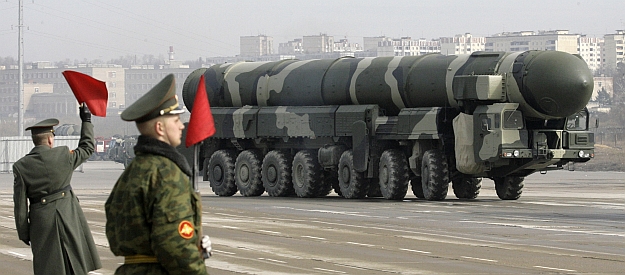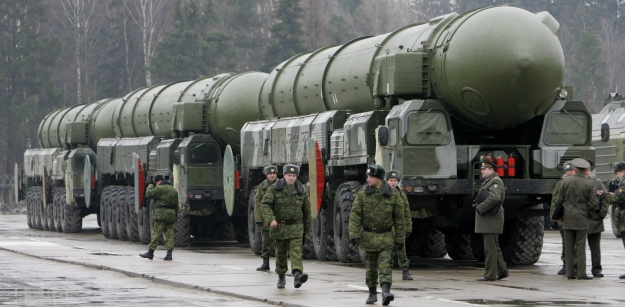 29.01.2015
29.01.2015FAILURE TO SAVE INF TREATY WOULD JEOPARDIZE EUROPEAN SECURITY

Vladimir Evseev
Termination of the Intermediate-Range Nuclear Forces Treaty could lead to an arms race in Europe and a rise in Cold War rhetoric.

The recent statements by the Pentagon, in which it admits the possibility of intermediate-range nuclear missiles (INF) returning to Europe, appear to place the future of the INF Treaty in jeopardy. These statements were made in response to the actions of Russia, which, according to the Pentagon, has violated this treaty banning the production and use of such weapons.
Moreover, Under Secretary of State for Arms Control and International Security for the U.S. State Department Rose Gottemoeller warned that if Russia violated the INF Treaty, it could result in more economic and diplomatic sanctions. Does such rhetoric pose a threat to the INF Treaty?
Is it possible that intermediate-range and shorter-range missiles could return to Europe? Or is it all just political saber-rattling? If true, to what extent would such a move jeopardize the existing system of security and could it spark a new arms race?
Return of the arms race?
At the end of long-ago 1987, the leaders of the Soviet Union and the United States met in Washington to sign the INF Treaty, which entered into force on June 1, 1988. The signatories pledged not to produce, test or deploy ballistic and cruise missiles with a medium (1,000-5,500 km) to short (500-1,000 km) range.
By June 1991 the treaty had been fully implemented: The Soviet Union had destroyed 1,846 guided-weapon systems, including ones manufactured but not in military service, while the United States had got rid of 846. At first glance, Moscow made considerably more concessions, both in terms of quantity and quality of short and medium-range missiles. But the decisive factor lay elsewhere: flight time to the USSR’s borders. On this parameter, the systems earmarked for annihilation were of strategic importance for the Soviets.
The INF Treaty was a cornerstone of European security, since it eliminated a broad class of ballistic and cruise missiles, significantly reducing the risk of nuclear war in Europe and obviating the need for a costly missile defense shield. Back then, Moscow and Washington were ready and willing to discuss the reduction of both nuclear and conventional weapons.
However, the Soviet leadership developed a somewhat idealized view of the situation, failing to raise the issue of restrictions on the deployment of U.S. cruise missiles at sea. Gradually this allowed Washington to advance the concept of “Prompt Global Strike,” a military effort to develop a system able to deliver a precision conventional (non-nuclear) weapon strike anywhere in the world within one hour.
Moscow later announced that, if implemented, a system of that caliber could inflict such a disarming blow to Russia’s strategic nuclear forces that it would render the Strategic Arms Reduction Treaty (START) unworkable.
Criticism of the INF Treaty subsequently increased. Russia declared that it should become multilateral and include other countries with ballistic missiles of this range. Moscow’s anxiety on this point was understandable, since its territory was in range of not only official nuclear powers such as China, France and Britain, but also India, Pakistan, Iran, Israel, Japan and North Korea.
In practice the proposal was clearly impractical, but it allowed Russia to shift the debate toward a potential withdrawal from the treaty along the lines of the United States’ exit from the Anti-Ballistic Missile Treaty in 2002.
Is Russia producing short- and long-range cruise missiles?
The Americans took a different approach. They began to make unsubstantiated accusations that Russia was in violation of the INF Treaty. In September 2014 a delegation headed by Rose Gottemoeller came to Moscow to discuss the issue, but no settlement was reached.

The lack of specifics on the subject suggests that Russia may be considering the development of a special type of warhead for ground-based missile systems such as the Topol-M and RS-24 Yars. This warhead would allow the nose of the missile to glide while in flight in the atmosphere. But it would fly at hypersonic speed, mainly in the upper and middle layers of the atmosphere, which is a crucial difference between such warheads and cruise missiles.
There is also speculation about a glide-cruise vehicle for the Iskander tactical missile system, which could be viewed as a kind of alternative cruise missile. However, its standard range would not exceed 500 km (310 miles), and the practical use of this type of warhead has yet to be confirmed.
Redeployment of cruise missiles in Europe?
In response, the Pentagon admitted the possibility of siting U.S. ground-based cruise missiles in Europe. This crude statement, intended to exert pressure, fails to take into account the sides’ actual capacity to deploy INF weapons. Russia, for instance, would have little trouble developing a medium-range ballistic missile based on the Topol-M.
The U.S. lacks such technical capability, so in the event of the country’s withdrawal from the INF Treaty it would have to limit itself to deploying ground-based cruise missiles based on the Aegis Ashore system, which can launch not only interceptor rockets, but also Tomahawk cruise missiles. However, the latter fly at subsonic speed, so could be comfortably intercepted by the Pantsir-S or Tor anti-aircraft missile systems, for instance. There would be serious resistance to their deployment in Europe due to the inevitable response from Russia.
New sanctions?
Recently the U.S. House of Representatives held hearings on Russia’s alleged violation of the INF Treaty, during which Rose Gottemoeller announced a new set of potential financial and economic sanctions and military measures against Moscow to “keep” it within the framework of the treaty.
In the view of the above, the following should be noted. Firstly, the U.S. has no conclusive evidence that Russia violated the terms of the INF Treaty. Therefore, instead of casting reproaches, Washington would be better advised to cease using target missiles (which are essentially medium-range ballistic missiles) in the development of its missile defense shield.
Secondly, the deployment of U.S. ground-based cruise missiles in Europe will not fundamentally alter the balance in conventional weapons. This is relevant in the case of new Russian medium-range ballistic missiles, against which a missile defense shield could be deployed. All this would lead to a major arms race and at least five years of high spending.
 Thirdly, U.S.-Russian talks on the further reduction of nuclear weapons are deadlocked as it is. This applies both to strategic weapons, where Russia is steadily increasing its nuclear capacity under the new (Prague) START Treaty, and to tactical nuclear weapons. The U.S. plans to upgrade its strategic arms by significantly improving their precision targeting capability, which is tantamount to doubling its stockpile of tactical nuclear weapons (TNW). Russia, in response, could deploy TNW in Crimea and the Kaliningrad Region. Pulling out of the INF Treaty would only accelerate these negative processes and create more problems than clear-cut advantages.
Thirdly, U.S.-Russian talks on the further reduction of nuclear weapons are deadlocked as it is. This applies both to strategic weapons, where Russia is steadily increasing its nuclear capacity under the new (Prague) START Treaty, and to tactical nuclear weapons. The U.S. plans to upgrade its strategic arms by significantly improving their precision targeting capability, which is tantamount to doubling its stockpile of tactical nuclear weapons (TNW). Russia, in response, could deploy TNW in Crimea and the Kaliningrad Region. Pulling out of the INF Treaty would only accelerate these negative processes and create more problems than clear-cut advantages.
Thus, preserving the INF Treaty is in both Russian and U.S. national interests. Unless that basic fact is understood, the sides cannot hope to find a way out of the present impasse and begin the complex process of restoring bilateral relations in the sphere of arms reduction and limitation.
http://www.russia-direct.org/analysis/failure-save-inf-treaty-would-jeopardize-european-securityReturn
